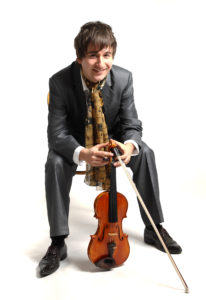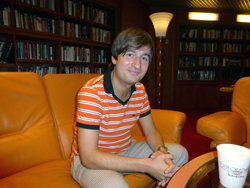Editor Donald H. Harrison is back from a roundtrip cruise between San Diego and the Hawaiian Islands. This is the sixth in a series of articles based on that experience.
By Donald H. Harrison

ABOARD MS ZAANDAM– Violinist Michael Bacala says he was inspired as a child by the Rocky movies starring Sylvester Stallone, especially by their Theodor Hertzl- like message that one should never give up on one’s dreams. Sometimes, the classically trained violinist introduces his shipboard concerts with an energetic rendition of “Eye of the Tiger” in salute to Stallone, and then for the 45 minutes allotted in a cruise ship performance he offers a program alternating between popular and classical music, with some self-deprecating humor thrown in.
Watching Bacala’s concerts, one thinks of other talented entertainers like Victor Borge, Danny Kaye and Jack Benny who believed that classical music when leavened with humor, could be made more accessible to lay audiences.
As a boy, Bacala used to sing a lot, enough so that his grandmother suggested to his mother that they take him to a music teacher to see if he had any musical talent. The teacher responded that, indeed he did, and Bacala chose the violin as his instrument. He liked the way it sounded, and besides, an uncle had a violin mounted on his wall as a decoration, though he never played it.
Bacala likes to tell his audiences that when he began practicing in his apartment building, his neighbors were very impressed. In fact, one neighbor was so determined to hear his music more clearly that he hurled a brick through his window!
No one appreciated Bacala’s music more than his mother, Elzbieta, who quit her job to take him to music school, rehearsals, auditions and the like. The first time she heard the story about the brick, she became very serious and said to her son, “I don’t remember such an incident.” Bacala responded that of course no such incident had really occurred; they had lived up on the sixth floor of their building, and no one could throw a brick that far — it was just a joke. But that’s not to say that the boy prodigy didn’t have some critics. There was one woman who lived below the Bacalas who actually went around the building with a petition demanding that he be required to practice somewhere else. Bacala outlasted her, and eventually she moved away.

The practice paid off when Bacala was accepted to the Academy of Music in his hometown of Lodz, which, he notes, once was a city with one of the largest Jewish populations in Poland prior to World War II. In his concerts, he plays a suite from Fiddler on the Roof as well as Hava Nagila in tribute to the Jews who were murdered during the Holocaust, which ended 35 years before he was born.
While a music student, Bacala was picked for two signal honors: performing in a 2003 concert for Poland’s native son, Pope John Paul II, in Zgierz, Poland, and in 2004 performing in Brussels, Belgium, as part of the ceremonies welcoming Poland into the European Union. Bacala continued his music education in Holland, Germany and Austria, but kept returning to his beloved Poland.
A Roman Catholic, Bacala came to the attention of the church hierarchy in Lodz when he volunteered to perform for free–or as he puts it “for a cup of tea and a piece of cake”–at several concerts that Bishop Lagwa of Lodz organized to restore an old church that otherwise would have faced demolition.
This volunteer work resulted in an invitation to be included in a concert for the Pope, during which he played “Ave Maria” by Schubert; a French waltz in which he was accompanied by a friend on accordion, and “Skylark,” a Romanian folk standard arranged by Grigoras Dinicu which Bacala has turned into his signature piece.
The fast violin piece includes a section in which the sounds of the skylark are imitated by the violinist. Bacala, however, has since “discovered many birds and animals” and has inserted violin approximations of many other sounds into this work, including those of a cat, dog, horse, cow, seagull and a sheep.
Nancy and I bumped into Bacala off the ship at a commercial internet store in Kuaui, an island which is roamed freely by chickens. After Bacala “skyped” to his wife, Magdalena, back home in Poland, he was serenaded by a rooster who had settled on the back of a chair inside the small business. As Bacala listened appreciatively to the rooster, I could not help but wonder if its call would be duplicated in a future performance.
During his ship concert, Bacala also performed “Ave Maria,” which he dedicated–as he always does–to Magdalena, remembering the music played at their wedding. He said he owes his career to the love and dedication of his wife, along with that of his mother and his British agent, Gary Parkes. Bacala transfers from one cruise ship to another; he disembarked the Zaandam in Hawaii in order to join the a ship of the Silversea fleet. His dream is to be honored as “guest entertainer of the year” within the cruise ship industry.
There have been many violinists who have inspired Bacala, both in the way they played and, as in the case of Yehudi Menuhin, what they thought. During his concert on MS Zaandam, Bacala paraphrased Menuhin as saying that a “violin can discover the greatest parts of the human soul.”
“For me,” Bacala added, “that intimate connection of a performer with an instrument is amazing. It is the most intimate connection: you have so close to your body this instrument and you can create so many kinds of color of sounds, through vibrato, touching strings, the different positions of the bow.”
He then played the Irish melody “Danny Boy” with such feeling, it made the eyes of some in the audience well up with sentimentality.
Asked about his favorite violinists, he responded that the answer depends on what kind of music one is listening to. For romantic classical music, for example, he favors the work of Jascha Heifetz, whereas for music more baroque, like that of Bach, he prefers the style of Henryk Szeryng. And, in his opinion, no one interprets Beethoven’s Violin Concerto as well as Itzhak Perlman.
He recalled once attending a party while a student and “I was listening to an interpretation of the famous D Minor Concerto by Jean Sibelius.” It was the second movement played by Heifetz, “and I said it is ‘just out of this world, nobody has played that part with such passion and feelings.’ For me the party was over, I was listening the whole night to that second movement of that violin concerto and I was just amazed. Heifetz is one of my favorite artists…”
With 45 minutes the window of time, Bacala is permitted for a concert, he favors short pieces such as Johann Strauss Jr.’s “Radetzky March” and “Time to Say Goodbye,” popularized by Andrea Bocelli, rather than longer violin pieces such as one of my favorites (as performed by Zina Schiff), “The Lark Ascending” by Ralph Vaughan Williams, which takes approximately 10 minutes.
Although “Skylark” is the signature performance piece that Bacala does again and again, he says that he would like to incorporate into his concerts–and introduce to international audiences — some of the works of talented Polish composers, about whom, he said, the world knows too little. Among hs favorites is Mieczyslaw Karlowicz, of whose “Violin Concerto in A Major” Bacala is enamored.
*
Harrison is editor of San Diego Jewish World. He may be contacted at donald.harrison@sdjewishworld.com